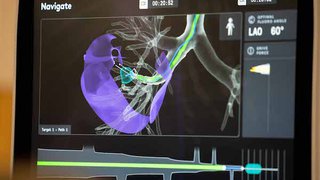When a doctor may recommend lung transplant to treat COPD, emphysema, or pulmonary fibrosis
October 11, 2017

This article was updated Nov. 1, 2019.
Everything we do depends on our ability to breathe – every movement, every thought or signal from our brains. So the effects can add up quickly when lung diseases, also known as pulmonary diseases, restrict our ability to breathe normally.
If we can’t improve a patient’s lung health through normal treatments, we may recommend a lung transplant. In 2018, our lung transplant team performed 68 transplantations. Survival rates for patients who have transplant surgery with us are the highest in North Texas as well.
Many of our patients have diseases such as emphysema and pulmonary fibrosis that cause them to need our help. Let’s discuss these conditions and what’s involved with them, along with how they can lead to the need for a lung transplant.
What is COPD, and what are its symptoms?
Chronic obstructive pulmonary disease, or COPD, is a condition that interferes with the normal breathing process. People who have COPD have trouble moving air in and out of their lungs. About 30 percent of our lung transplant patients have some form of COPD, such as emphysema, the most common type of COPD.
COPD typically is caused by being exposed to substances that irritate or injure the lungs. Though dust, chemicals, or other substances can lead to someone developing COPD, the most common cause is smoking.
If you have COPD, you may notice these symptoms:
- Bluish-colored skin of the lips or fingernail beds (cyanosis)
- Chronic coughing that can produce a lot of mucus
- Feeling tired or out of energy
- Shortness of breath, especially during exercise
- Swollen ankles, feet, or legs
- Tightness or pain in the chest\
- Wheezing
As the National Institutes of Health notes, about 12 million adults in the U.S. have been diagnosed with some form of COPD, but researchers believe another 12 million have the disease and haven’t been diagnosed. The Centers for Disease Control and Prevention reports that about 5.4 percent of Texans have been diagnosed with COPD.
Emphysema: The most common form of COPD
People with emphysema have damage to the lungs’ air sacs, called alveoli. The alveoli transfer oxygen from the lungs to the blood, which carries oxygen to all the organs and tissues of the body. Because of the damage done to the alveoli, people with emphysema don’t get enough oxygen.
As with other forms of COPD, cigarette smoking is the top reason people develop emphysema. People exposed to secondhand cigarette smoke, as well as industrial dusts and chemicals, also are at risk. About 3 million Americans have been diagnosed with emphysema.
What is pulmonary fibrosis, and what causes it?
Pulmonary fibrosis, also known as interstitial lung disease, is a term used to refer to a number of lung conditions that affect the lungs in a similar way. Fibrosis is scar tissue, and pulmonary fibrosis involves the buildup of scar tissue in the lungs, preventing the lungs from getting enough oxygen. About 45 percent of our patients who receive lung transplants have some form of pulmonary fibrosis.
There are many causes of pulmonary fibrosis, the most common of which include:
- Autoimmune disorders, such as lupus or rheumatoid arthritis
- Exposure to inhaled substances that damage the lungs, including cigarette smoke and asbestos
- Genetic factors that run in families
- Granulomatous diseases, which cause a type of inflammation in the lungs called granulomas
- Some medications, including chemotherapy medications and long-term use of some antibiotics
Sometimes we can’t find a cause for a patient’s pulmonary fibrosis. We call these cases idiopathic (“unknown cause”) pulmonary fibrosis.
The most common symptoms of pulmonary fibrosis are coughing and shortness of breath. Other symptoms can include feeling weak or tired or having no appetite.
These symptoms usually are mild or unnoticeable early in the disease process but get worse as more scar tissue builds up in the lungs. Eventually, even simple activities such as talking on the phone or eating may cause sufferers to feel winded or out of breath.
We treat patients who have pulmonary fibrosis in our Interstitial Lung Disease & Pulmonary Fibrosis Program. Learn more about the program.

Deciding to have a lung transplant
In my experience, patients with COPD or emphysema tend to be pretty limited in what they can do physically, which significantly compromises their quality of life. When we can’t improve COPD or emphysema with standard measures, we might recommend a lung transplant.
People with COPD typically have to wait the longest for lung transplants. That’s because their risk of dying isn’t as high as some other potential transplant patients. But people with COPD may be able to have just a single-lung transplantation, which can move them up higher on the list than someone who must wait for two donor lungs to be available.
On the other hand, patients who have pulmonary fibrosis tend to be higher on the lung transplant waiting list. We try to get them on the list quickly because their disease is so unpredictable, and they could die suddenly while they’re waiting for a transplant.
I encourage any patient with pulmonary fibrosis to be referred to a pulmonary fibrosis center of excellence, such as our Interstitial Lung Disease & Pulmonary Fibrosis Program, as early as possible. Specialists at such centers can provide advanced medical care for this challenging disease and get patients on the waiting list for a transplant as soon as possible if they’re not responding to advanced medical therapy.
It’s important to understand the benefits and potential risks of lung transplant surgery. Talk to your pulmonologist about whether you’re a good candidate for a lung transplant.
Healthy, full lives after lung transplant
The results after a lung transplant can be remarkable. Usually, just two weeks after receiving a lung transplant, patients are out of the hospital. Most transplant patients have been on oxygen for some time before their surgeries, and being able to walk without being short of breath and without dragging around oxygen tanks is a huge shock to them. We have to train them how to breathe on their own again without the oxygen lines.
One month after surgery, transplant patients are fully independent. Three months afterward, they can do daily activities without the fear of a lack of oxygen, or hypoxia. And six months after transplantation, they’re performing equally as well as people their own age with no lung problems.
I always feel so fulfilled when one of my transplant patients shares a success story with me. About a year ago, a 22-year-old patient sent me a photo from a mountain in Colorado where he’d been hiking – something that would have been impossible before his surgery. Another of my patients sent me a picture of her receiving a medal in a competition for people who have been either donors or recipients of lifesaving transplants.
And sometimes I get to see the results for myself. All our transplant patients get together once a year for our Celebration of Thanksgiving for the Gift of Transplantation Medicine event. At our 2016 gathering, we chose a lung transplant patient to share his story. This patient used to play trumpet in a small orchestra, but he hadn’t been able to play for years because of his disease. Six months after his lung transplant, he played the trumpet again for all of us to hear. Stories like that are what drive me to help patients who are struggling because of COPD, emphysema, and pulmonary fibrosis.
No one should have to worry about being able to take their next breath. Our transplant program helps patients take breathing for granted again. And I look forward to helping many more North Texas patients breathe easier.












